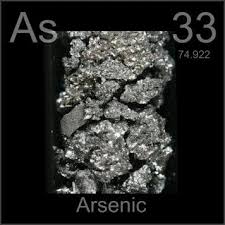- Arsenic is a naturally occurring allotropic pnictogen and metalloid trace element with atomic symbol As, atomic number 33, and atomic weight 74.92 that is found in water, air, food, and soil, and has a role as a micronutrient.
- Arsenic (As) has 33 protons, giving it an atomic number of 33 and, in it's most common isotope, it has 42 neutrons. Atomic mass is equal to (number of protons + number of neutrons).
- Arsenic (As) Atomic Data for Arsenic (As) Atomic Number = 33 Atomic Weight = 74.9216 Reference E95: Isotope: Mass: Abundance: Spin: Mag Moment: 75 As: 74.921594: 100%: 3/2 +1.43947: As I Ground State 1s 2 2s 2 2p 6 3s 2 3p 6 3d 1 0 4s 2 4p 3 4 S.

Molar mass of As = 74.92160 g/mol
Convert grams Arsenic to moles or moles Arsenic to grams
The atomic mass of arsenic = 74.92 g/mol. The mass of 0.0406 mol of arsenic = 0.0406 mol x 74.92 (g/mol) = 3.05 g. The answer is 3.0g. Another way to consider this (same idea - just expressed differently) is what mol% does the As represent in As2S3. Two atoms of arsenic weigh 2 x 74.92 = 149.84 amu (atomic mass units - where 1 amu = molar mass. Physical Properties of Arsenic. Atomic Mass Average: 74.92159; Boiling Point: 876K 603.
| Symbol | # of Atoms | Arsenic | As | 74.92160 | 1 | 100.000% |
In chemistry, the formula weight is a quantity computed by multiplying the atomic weight (in atomic mass units) of each element in a chemical formula by the number of atoms of that element present in the formula, then adding all of these products together.
Formula weights are especially useful in determining the relative weights of reagents and products in a chemical reaction. These relative weights computed from the chemical equation are sometimes called equation weights.
A common request on this site is to convert grams to moles. To complete this calculation, you have to know what substance you are trying to convert. The reason is that the molar mass of the substance affects the conversion. This site explains how to find molar mass.
Finding molar mass starts with units of grams per mole (g/mol). When calculating molecular weight of a chemical compound, it tells us how many grams are in one mole of that substance. The formula weight is simply the weight in atomic mass units of all the atoms in a given formula.
If the formula used in calculating molar mass is the molecular formula, the formula weight computed is the molecular weight. The percentage by weight of any atom or group of atoms in a compound can be computed by dividing the total weight of the atom (or group of atoms) in the formula by the formula weight and multiplying by 100.
Using the chemical formula of the compound and the periodic table of elements, we can add up the atomic weights and calculate molecular weight of the substance.
The atomic weights used on this site come from NIST, the National Institute of Standards and Technology. We use the most common isotopes. This is how to calculate molar mass (average molecular weight), which is based on isotropically weighted averages. This is not the same as molecular mass, which is the mass of a single molecule of well-defined isotopes. For bulk stoichiometric calculations, we are usually determining molar mass, which may also be called standard atomic weight or average atomic mass.
Chemical properties of arsenic - Health effects of arsenic - Environmental effects of arsenic
|
Arsenic Neutron
|
Arsenic is one of the most toxic elements that can be found. Despite their toxic effect, inorganic arsenic bonds occur on earth naturally in small amounts. Humans may be exposed to arsenic through food, water and air. Exposure may also occur through skin contact with soil or water that contains arsenic. A lethal dose of arsenic oxide is generally regarded as 100 mg. |
Environmental effects of arsenic
The arsenic cycle has broadened as a consequence of human interference and due to this, large amounts of arsenic end up in the environment and in living organisms. Arsenic is mainly emitted by the copper producing industries, but also during lead and zinc production and in agriculture. It cannot be destroyed once it has entered the environment, so that the amounts that we add can spread and cause health effects to humans and animals on many locations on earth. Plants absorb arsenic fairly easily, so that high-ranking concentrations may be present in food. The concentrations of the dangerous inorganic arsenics that are currently present in surface waters enhance the chances of alteration of genetic materials of fish. This is mainly caused by accumulation of arsenic in the bodies of plant-eating freshwater organisms. Birds eat the fish that already contain eminent amounts of arsenic and will die as a result of arsenic poisoning as the fish is decomposed in their bodies. More information on properties of arsenic Read more on arsenic in water Information on arsenicosis |
Back to the periodic table of elements
More from 'Elements'
Lenntech (European Head Office)
Arsenic Protons Electrons Neutrons
Distributieweg 3
2645 EG Delfgauw
The Netherlands
Phone: +31 152 610 900
fax: +31 152 616 289
e-mail: info@lenntech.com
Lenntech USA LLC (Americas)
5975 Sunset Drive
South Miami, FL 33143
USA
Phone: +1 877 453 8095
e-mail: info@lenntech.com
Lenntech DMCC (Middle East)
Atomic Mass Vs Atomic Number
Level 5 - OFFICE #8-One JLT Tower
Jumeirah Lake Towers
Dubai - U.A.E.
Phone: +971 4 429 5853
e-mail: info@lenntech.com
Lead Arsenate Atomic Mass
Copyright © 1998-2021 Lenntech B.V. All rights reserved
